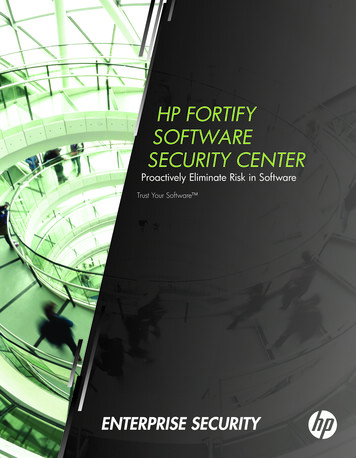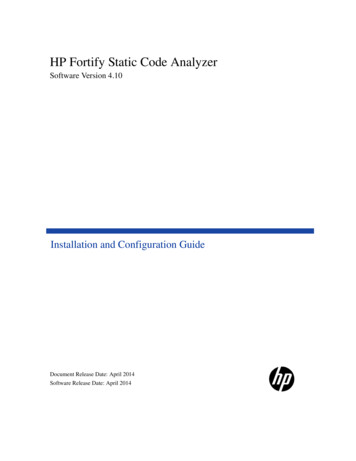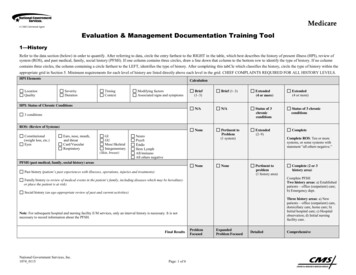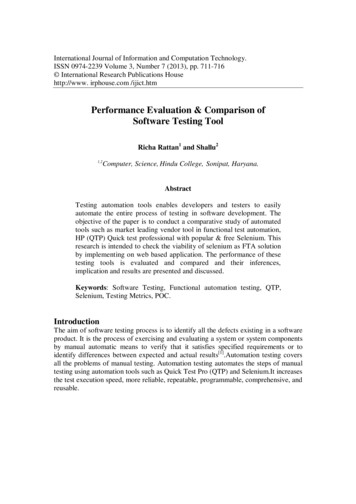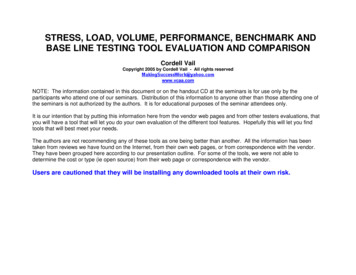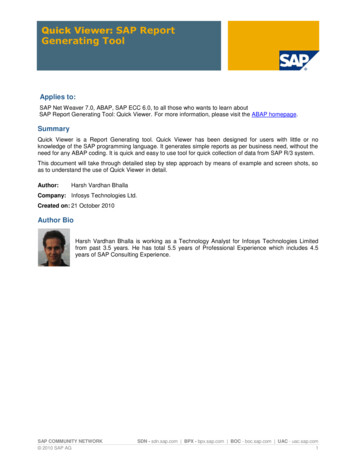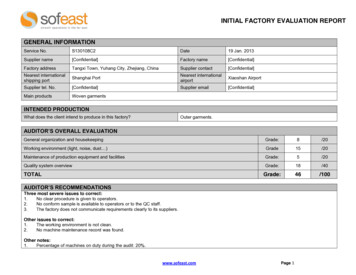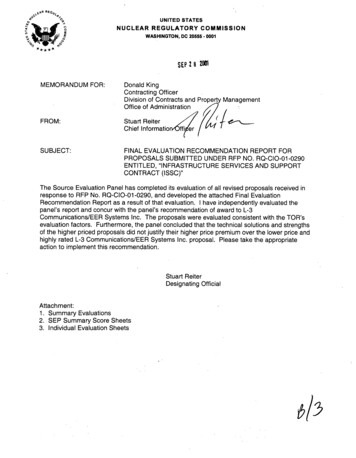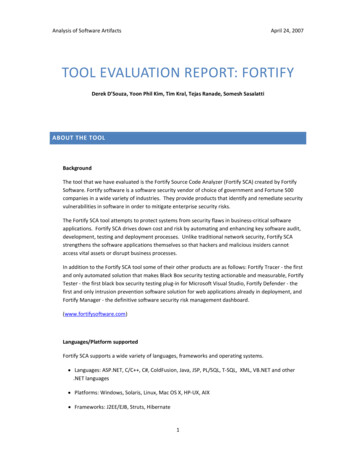
Transcription
Analysis of Software ArtifactsApril 24, 2007TOOL EVALUATION REPORT: FORTIFYDerek D’Souza, Yoon Phil Kim, Tim Kral, Tejas Ranade, Somesh SasalattiABOUT THE TOOLBackgroundThe tool that we have evaluated is the Fortify Source Code Analyzer (Fortify SCA) created by FortifySoftware. Fortify software is a software security vendor of choice of government and Fortune 500companies in a wide variety of industries. They provide products that identify and remediate securityvulnerabilities in software in order to mitigate enterprise security risks.The Fortify SCA tool attempts to protect systems from security flaws in business-critical softwareapplications. Fortify SCA drives down cost and risk by automating and enhancing key software audit,development, testing and deployment processes. Unlike traditional network security, Fortify SCAstrengthens the software applications themselves so that hackers and malicious insiders cannotaccess vital assets or disrupt business processes.In addition to the Fortify SCA tool some of their other products are as follows: Fortify Tracer - the firstand only automated solution that makes Black Box security testing actionable and measurable, FortifyTester - the first black box security testing plug-in for Microsoft Visual Studio, Fortify Defender - thefirst and only intrusion prevention software solution for web applications already in deployment, andFortify Manager - the definitive software security risk management orm supportedFortify SCA supports a wide variety of languages, frameworks and operating systems. Languages: ASP.NET, C/C , C#, ColdFusion, Java, JSP, PL/SQL, T-SQL, XML, VB.NET and other.NET languages Platforms: Windows, Solaris, Linux, Mac OS X, HP-UX, AIX Frameworks: J2EE/EJB, Struts, Hibernate1
Analysis of Software ArtifactsApril 24, 2007 IDEs: Microsoft Visual Studio, Eclipse, Web Sphere Application Developer, IBM RationalApplication DeveloperHow it WorksFortify SCA is a static analysis tool and it processes code in a manner similar to a code compiler. Ituses a build tool that runs on a source code file or set of files and converts it into an intermediatemodel that is optimized for security analysis by Fortify. This model is put through a series of analyzers(Data flow, Semantic, Control Flow, Configuration, and Structural). Fortify SCA also uses Fortify SecureCoding Rule Packs to analyze the code base for violations of secure coding practices. Fortify RulesBuilder allows to extend and expand analysis capabilities to include custom rules as well. The resultscan be viewed in a number of ways using the Audit Workbench and the Fortify ca/scaHowItWorks.jsp)Capabilities/FeaturesFortify SCA is used to find and fix following software vulnerabilities at the root cause: BufferOverflow, Command Injection, Cross-Site Scripting, Denial of Service, Format String, Integer Overflow,Log Forging, Password, Management, Path Manipulation, Privacy Violation, Race Conditions, SessionFixation, SQL Injection, System Information Leak, and Unreleased Resource. It sorts, filters, prioritizes2
Analysis of Software ArtifactsApril 24, 2007and categorizes the issues found in various forms for easy viewing and analysis through the AuditWorkbench and Fortify Manager. The results can also be exported as a report in formats such as htmland xml. The SCA tool supports integration with black box security testers such as Watchfire’sAppscan and it also supports integration with Findbugs for central security and quality issuereporting.TOOL AND EXPERIMENTS SETUPTool SetupThe SCA tool comes in three editions: Enterprise, Team, and Developer. We used the Team Editionwhich is intended for smaller organizations, and consists of Fortify SCA, Fortify Audit Workbench, andFortify Rules Builder. We believe this edition will be the most relevant and interesting to other MSEand MSIT students because the majority of studio and practicum projects are being done in aWindows environment with small teams. The tool was downloaded with the evaluation license fromwww.fortifysoftware.comArtifactsWe ran Fortify SCA on the following artifacts: OpenSSH (Large C/C code base) – we used the tool on this project to test its analysis on a largewell-known code base. Small C/C application injected with bugs – we created a small test file that we injected withbugs to test precisely for false positives, false negatives, and effectiveness of the tool in findingbugs. JSPWiki (Large Java code base) – we used the tool on this project to evaluate it on a differentlanguage (Java) and to compare it with existing bug reports on the tool to test its efficacy. Crystal (Small Java code base) – we used the tool on Crystal to evaluate a project that we haveactively been using this semester and have some familiarity with.How to UseAn analysis can be performed with the Fortify SCA tool in two steps:1) Use the command line to run the sourceanalyzer on the project source files and obtain a .fpr file.2) Use the Audit workbench or Fortify Manager on the .fpr file to explore the results of the analysis.3
Analysis of Software ArtifactsApril 24, 2007The first step in performing an analysis involves running a series of commands at the command lineprompt to build the source files. For Java projects, the classpath and the source folder or file must beprovided. For C/C projects, a makefile is required. Once the build is successful, a .fpr file isgenerated on which we ran the Audit Workbench to analyze the results.The screenshot shows the Fortify Audit workbench used to analyze the Crystal code base:Fig 1: Screenshot of Fortify SCA Audit WorkbenchThe list of issues grouped as “Warnings” can be viewed here with the Null Deference bug highlighted.It zooms in on the piece of code that contains the bug. The bottom right box shows a summary of thebug as well as details in separate tabs. The bottom left box gives the bug trace found in the analysis.4
Analysis of Software ArtifactsApril 24, 2007EVALUATION CRITERIAPerformanceWe measured the performance in terms of the time required for the analysis to complete, memory usage,and CPU usage. These criteria helped us determine if the tool was reasonable in its usage of resources,and how it performed on different codebases. Our evaluation was limited to a large C codebase, and amedium sized Java codebase. An interesting observation was that even on a large code base likeOpenSSH, SCA’s performance was quite impressive. Although the custom build took long, the actual scantime of 2.45 minutes to scan 53000 lines of code across 152 files is noteworthy.CriteriaSize of the code base (KLOC)LanguageCPU UsageMemory usage (K bytes)Execution time 0000173JSPWiki35Java50%25000.31Number of bugs and quality of the findingsThe tool reports bugs in four categories: (1) semantic, (2) data flow, (3) structural and (4) control flow. Inaddition, bugs are categorized as “Hot issues”, “Warnings” and “Information”. Although the number ofbugs reported, particularly for OpenSSH and JSPWiki is high, the categorization of bugs makes it mucheasier to understand and prioritize them. The tool also allows the user to configure the prioritization ofbugs, which makes it possible to specify what you believe is important for the system being analyzed.On OpenSSH and JSPWiki, the bug lists have entries in the order of a few hundred. One can notice fromthe bug list that there several types of errors found. Each of them relates to some security vulnerabilitythat can be exploited. Some of the common ones are buffer overflows, unreleased resource errors,memory leaks etc. In addition to these, some bugs that can be very important in security analysis werealso reported. For example, the tool reports denial of service bugs, which can occur when a thread sleepsfor variable time. Another useful report was that of command injections for command executions that userelative paths. Such a bug can be exploited by a malicious user by changing the environment variable topoint to malicious code. Fortify identifies parts of the code where such paths are used.On Crystal, the tool reported 4 bug warnings and 145 miscellaneous notes. The finding that was mostuseful was a null deference bug that would have caused a null pointer exception every time that piece ofcode was run. There were two instances where getStackTrace() was called that the tool reported asSystem Information warnings since it could potentially provide important system information which canbe exploited by an attacker. In addition, the tool found an instance of an unreleased resource after5
Analysis of Software ArtifactsApril 24, 2007getPrintWriter() was being called. The 145 notes provided useful information in categories of issues suchas poor error handling, poor logging practices, model violations, and dead code found in Crystal.Level of Detail in the ReportsFor all the issues the tool finds, the level of detail is sufficient to gain an understanding of what theproblem is. Double clicking on a specific issue zooms in on the portion of the problematic code. Fortifyprovides both summary and detailed descriptions of all bugs found. Detailed summaries include a fullexplanation about the type of bug found, why it is a bug, where in the current source code it is occurring(including data flow traces if applicable), fully explanatory examples of the bug in sample code and insome cases, references for further reading about the bug. The tool also provides sample code to illustratehow the issue can potentially be exploited by an attacker of the system.Suggested fixes, fixing timeFor each of the issues found, the tool provides a list of recommendations and tips. Some of these arehelpful, but some are not. For example, for the null deference bug the tool’s recommendation was“Security problems caused by dereferencing null pointers are almost always related to the way in whichthe program handles runtime exceptions. If the software has a solid and well-executed approach todealing with runtime exceptions, the potential for security damage is significantly diminished.”This does not provide any particularly useful information for fixing the bug and seems more likebackground information on the issue. However, for some other bugs, the recommendations alsocontained useful sample code which can be used as reference for fixing the bug.Given that some of the recommendations are quite specific, the fix time for bugs is low. Even for thereports that do not provide very useful suggestions, the location of the bug can be pin-pointed, whichmakes it a lot simpler to debug. We found Fortify to be more intuitive for fixing bugs than most of theanalysis tools we have used during this course.False Positives:On the whole, the tool does not report a large percentage of false positives in comparison to the numberof bugs reported. It does; however, report some false positives. The Fortify tool website alsoacknowledges this in a disclaimer.Among the false positives we noticed, here is an example: The tool assumes that dynamic memory is freed within the scope of a function. As a result, ifcustom free methods are called, it throws a potential memory leak. A code snippet thatillustrates this is shown below:{int *ptr (int*)malloc(2*sizeof(int));6
Analysis of Software ArtifactsApril 24, 2007Myfree(ptr);}Myfree(int *ptr){free(ptr);}In this snippet, the memory allocated to ptr is released in the method Myfree(int *). However,the tool does not understand that the memory is freed in another method which is outside thescope of ptr. This is a common source of false positives in the SSH source code. Another source of false positive that we observed was the report of a SQL injection at placeswhere we did not find any hint of a dynamic SQL query generation. This type of result wasobserved in JSPWiki code.False Negatives / Overlooks:One of our interesting investigations involved trying to find false negatives. Our approach, as documentedin the proposal, was to compare the results of the tool with the bugs reported on the bug list in an opensource forum. We did not have a substantial degree of success finding open source software which wecould use that had well documented bug-lists. However, we did find an instance of a false negative in theanalysis of JSPWiki. Here is the sample.1 String password profile.getPassword();2 String existingPassword ( existingProfile null ) ? null : existingProfile.getPassword();3 if ( "".equals( password ) ){4password null;5}6 if ( password null){7 password existingPassword;8}9 // If password changed, hash it before we save10 if ( !password.equals( existingPassword ) ) There is a null dereference error in line 10 of the code displayed above. Although password is beingchecked previously for null value, it is actually being assigned to existingPassword (line 7). NowexistingPassword can very well be null, as indicated by line 2. Therefore, there is a possibility of a nulldereference in line 10, but Fortify fails to catch it. This bug was one of the bugs noticed in the forum, andcorrected thereafter.(Ref. nSavingTheUserProfileJDBC)Another observation was that the tool does not identify shallow copy as an illegal operation. If an alias toa pointer is created, then the tool does not warn that an inappropriate operation might result.7
Analysis of Software ArtifactsApril 24, 2007Usability:GoodAn audit workbench is available for viewing theresults and analyzing the issues. The auditworkbench we used was an Eclipse plug-in. Theworkbench is very easy to use, and it reports thebugs in an understandable fashion; includingcolor-coding for severity, hierarchies based on bugtypes and file structures. It also allows easylocation of bugs in the source code.Other than the files that need to be generatedautomatically, the tool does not req
Fortify software is a software security vendor of choice of government and Fortune 500 companies in a wide variety of industries. They provide products that identify and remediate security vulnerabilities in software in order to mitigate enterprise security risks. The Fortify SCA tool attempts to protect systems from security flaws in business-critical software applications. Fortify SCA drives .
